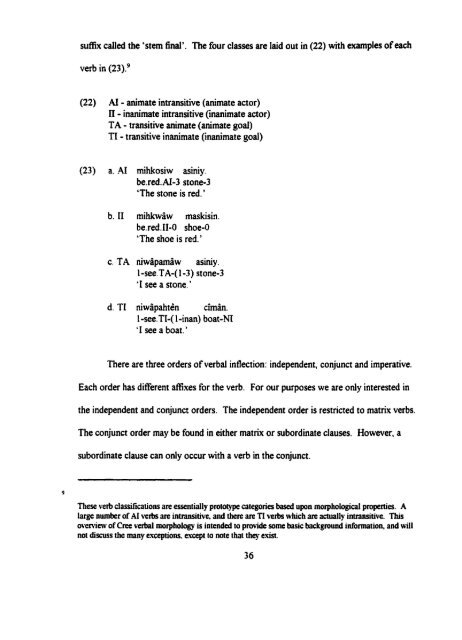Adverbial and Argument-Doubling Clauses in Cree - MSpace
Adverbial and Argument-Doubling Clauses in Cree - MSpace
Adverbial and Argument-Doubling Clauses in Cree - MSpace
You also want an ePaper? Increase the reach of your titles
YUMPU automatically turns print PDFs into web optimized ePapers that Google loves.
suffix called the 'stem f<strong>in</strong>al'. The four classes are laid out <strong>in</strong> (22) with examples of each<br />
verb <strong>in</strong> (23)'<br />
AI - animate <strong>in</strong>transitive (animate actor)<br />
II - <strong>in</strong>animate <strong>in</strong>transitive (<strong>in</strong>animate actor)<br />
TA - transitive animate (animate goal)<br />
TI - transitive <strong>in</strong>animate (<strong>in</strong>animate goal)<br />
mihkosiw as<strong>in</strong>iy.<br />
be. red. AI-3 stone-3<br />
'The stone is red.'<br />
mihkwâw maskis<strong>in</strong>.<br />
be. red. 11-0 shoe-0<br />
'The shoe is red.'<br />
niwâpamâw as<strong>in</strong>iy .<br />
1 -see.TA-( 1 -3) stone -3<br />
'1 see a stone. '<br />
niwâpahtén cimàn.<br />
1 -see.TE( 1 -<strong>in</strong>an) boat-NI<br />
'1 sec a boat. '<br />
There are three orders of verbal <strong>in</strong>flection: <strong>in</strong>dependent, conjunct <strong>and</strong> imperative.<br />
Each order has different attixes for the verb. For our purposes we are only <strong>in</strong>terested <strong>in</strong><br />
the <strong>in</strong>dependent <strong>and</strong> conjunct orders. The <strong>in</strong>dependent order is restricted to matrix verbs.<br />
The conjunct order rnay be found <strong>in</strong> either matrix or subord<strong>in</strong>ate clauses. However, a<br />
subord<strong>in</strong>ate clause can only occur with a verb <strong>in</strong> the conjunct.<br />
These verb classifications are essentially prototype aiegories based upon morphologic.1 properties. A<br />
large number of 41 verbs an <strong>in</strong>transitive, <strong>and</strong> there are Ti verbs which an actually <strong>in</strong>transitive. This<br />
ovewiew of <strong>Cree</strong> verhl morphology is <strong>in</strong>tended to provide some basic background <strong>in</strong>formation, <strong>and</strong> niIl<br />
not discuss the many exceptions, except to note that they esîst








![an unusual bacterial isolate from in partial fulf]lment for the ... - MSpace](https://img.yumpu.com/21942008/1/190x245/an-unusual-bacterial-isolate-from-in-partial-fulflment-for-the-mspace.jpg?quality=85)




![in partial fulfil]ment of the - MSpace - University of Manitoba](https://img.yumpu.com/21941988/1/190x245/in-partial-fulfilment-of-the-mspace-university-of-manitoba.jpg?quality=85)


